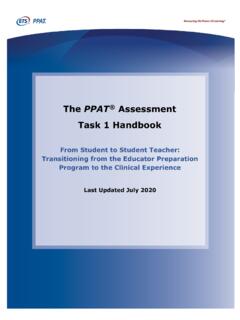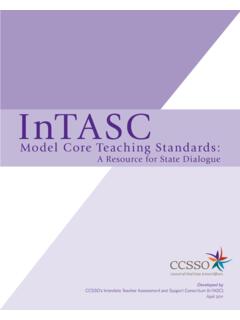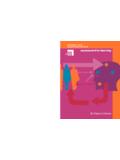Transcription of Understanding Formative Assessment - WestEd
1 >> April 2013 WestEd >> Understanding Formative AssessmentInsights from learning Theory and Measurement Theoryby Elise Trumbull and Andrea LashThis paper explores Formative Assessment , a process intended to yield information about student learning information that teachers can use to shape instruction to meet students needs and that students can use to better understand and advance their learning . This pur-pose promoting learning by informing instruction distinguishes it from other kinds of student Assessment , such as diagnostic, which is used to identify students who have special learning needs, or sum-mative, which is used by teachers to form final judgments about what students have learned by the end of a course, or is used at the state level for the purpose of evaluating , educators are calling for education Assessment systems that are more balanced, and that yield useful information for a vari-ety of education purposes, from how to shape ongoing instruction in the classroom to accountability decisions made at the state level (Darling-Hammond & Pecheone, 2010; Pellegrino, 2006; Wilson & Draney, 2004; Pellegrino, Chudowsky, & Glaser, 2001).
2 They are also calling for coherent sys-tems, in which assessments at all levels (from classroom to state) would be aligned with the same learning goals and views of what constitutes learning and would produce relevant information about student learning over time (Herman, 2010; Pellegrino, 2006). The purpose of this paper is to help readers understand the impor-tance and potential of Formative Assessment as a key component of This paper comes at a time in education when this last purpose, school accountability, has been dominating Assessment use for more than a quarter of a century (Shepard, 2006). Since implemen-tation of No Child Left Behind in 2001, state departments of edu-cation have assessed students annually in English language arts and mathematics with tests that survey a broad spectrum of content. Although each stu-dent is assessed, these tests are not intended to help identify an individual student s learning needs or to provide information that can be used to modify sub-sequent instruction.
3 Instead, the tests serve an accounting or mon-itoring function, such as counting the number of individuals who meet grade-level standards; test results of individual students are aggregated into reports of school and district progress, reports that are useful for district- and state-level decision-makers. But while such tests may identify students who lack the knowledge and skills expected for their grade level, these achievement tests do not identify why students are not proficient; the tests are not linked closely enough to classroom instruction and curriculum to identify what misconceptions stu-dents hold or what skills they are missing, information that could help guide instruction. This paper is one in a series produced by WestEd on the topic of Formative >>2a balanced and coherent assess-ment system a component that has been somewhat eclipsed by the focus on Assessment for account-ability purposes.
4 The paper first describes Formative Assessment and its key features. It then turns to learning theory and measure-ment theory and their implica-tions for effective use of Formative Assessment . Subsequent to that, and prior to the conclusion, is a brief review of summaries of research on how Formative assess-ment affects student of Formative Assessment in Classroom InstructionBlack and Wiliam (1998a) char-acterize Formative Assessment as all those activities undertaken by teachers and/or by their students [that] provide information to be used as feedback to modify the teaching and learning activities in which they are engaged (p. 7). The goal of any modifications to instruction is enhanced stu-dent learning . It is often claimed that the practice of Formative Assessment is rooted in Bloom s concept of mastery learning , an instructional approach that espouses the use of assessments to gauge students progress toward mastering a learning goal (Bloom, Hastings, & Madaus, 1971).
5 Bloom suggested that, rather than waiting to assess stu-dents at the end of a unit (common practice at the time), teachers use assessments as an integral part of the instructional process to identify individual learning dif-ficulties and prescribe remedia-tion procedures (Guskey, 2010, p. 108). According to Guskey, Bloom borrowed the term for-mative from Scriven (1967), who used it to describe program evalu-ation activities conducted during the course of a program to give feedback on the program s prog-ress so that it could be improved if need Assessment does not take the form of a particular instrument or task (Moss, 2008), but is defined by its purpose (Shepard, 2009), which is to help form, or shape, a student s learn-ing during the learning process. Some suggest that Formative Assessment is better described as a process ( using Assessment for-matively [Frohbeiter, Greenwald, Stecher, & Schwartz, 2011, p.)]
6 3]) than as a type of Assessment (see also McManus, 2008). Erickson (2007) has used the term proxi-mal Formative Assessment to indicate that it is an activity close to instruction (Ruiz-Primo, Shav-elson, Hamilton, & Klein, 2002). Erickson (2007) defines it as the continual taking stock that teachers do by paying firsthand observational attention to stu-dents during the ongoing course of instruction careful attention focused upon specific aspects of a student s developing under-standing (p. 187) in order to make decisions about next steps in instruction (see also Heritage, Kim, Vendlinski, & Herman, 2009). To facilitate this process, the teacher needs to use practices that will reveal not only whether a student appears to have mas-tered a concept but also how he or she understands it (Pryor & Crossouard, 2005).
7 The assess-ment practices need to be so well grounded in the instructional process that the information they reveal will identify whether and how instruction should be adapted to advance students understandings. Heritage, who has made significant contribu-tions to the theory and practice of Formative Assessment , empha-sizes the close linkage if not the inseparability of Formative Assessment , teaching, and learn-ing (Heritage, 2010a). In theory, any Assessment includ-ing a commercially developed test could be used for Formative purposes. However, as Pellegrino et al. (2001) caution, using the same assessments for different purposes tends to lessen their effectiveness for each purpose (see also Shavelson, Black, Wiliam, & Coffey, 2007). For example, it would be difficult to design an Assessment for school account-ability systems that elicits student performance at the level necessary for fine-grained Understanding of individual learning needs without compromising the scope neces-sary for an accountability measure or without making excessive time Formative Assessment is defined by its purpose which is to help form, or shape, a student s learning during the learning process.
8 Understanding Formative Assessment : Insights from learning Theory and Measurement Theory>> April 2013 WestEd >>3demands for administration and scoring. Such accountability assessments are generally not cou-pled closely enough to instruction to instruction to yield information that would help a teacher think about what a student might need in order to better learn what has been assessed. To serve a Formative purpose, Assessment needs to provide action-able information for teachers and students (Heritage, 2010a; Shepard, 2005). Ideally, it reveals something about a student s progress toward certain learning goals, the stu-dent s thought processes, and any misconceptions the student may hold (Supovitz, 2012). Formative Assessment is highly contingent on the instructional situation and the student(s) (Black & Wiliam, 2009, p. 12). Thus, it should be tailored to the particular students being assessed, the relevant learn-ing targets, and a specified point in the instructional process; also, it should take a form most likely to elicit the desired learning evidence (Ruiz-Primo & Li, 2011).
9 There can be no prescription for what a single instance of Formative assess-ment should look like. Any instruc-tional activity that allows teachers to uncover the way students think about what is being taught and that can be used to promote improve-ments in students learning can serve a Formative Assessment is often highly integrated with instruc-tion (Herman et al., 2006) and most commonly takes the form of classroom exchanges between teachers and students (or, less commonly, between students ). These exchanges have the potential to make students thinking explicit and thus open to examination and revision. In this way, the exchanges serve as learning opportunities (Ruiz-Primo, 2011). Given insights into students thinking, a teacher is in a position to counter mis-conceptions and steer learning back on track through feedback or instructional modifications (Black & Wiliam, 2004).
10 Teachers can also mentor students to become proficient at asking their own questions of each other and responding with ideas, reasoning, and evidence, as well as providing feedback to each other (Black & Wiliam, 1998b). Some have called feedback the linchpin that links the components of the Formative Assessment process (Brookhart, Moss, & Long, 2010, p. 41). Feedback is information pro-vided by an agent ( , teacher, peer, parent, the Assessment itself) regarding aspects of one s performance or Understanding (Hattie & Timperley, 2007, p. 81). Feedback takes on a Formative role when it provides information about the gap between a student s current Understanding and the desired level of Understanding , and it is most effective for the stu-dent when it is targeted at the right developmental level and helps the student identify ways to close the gap (Hattie & Timperley, 2007; Sadler, 1989).





